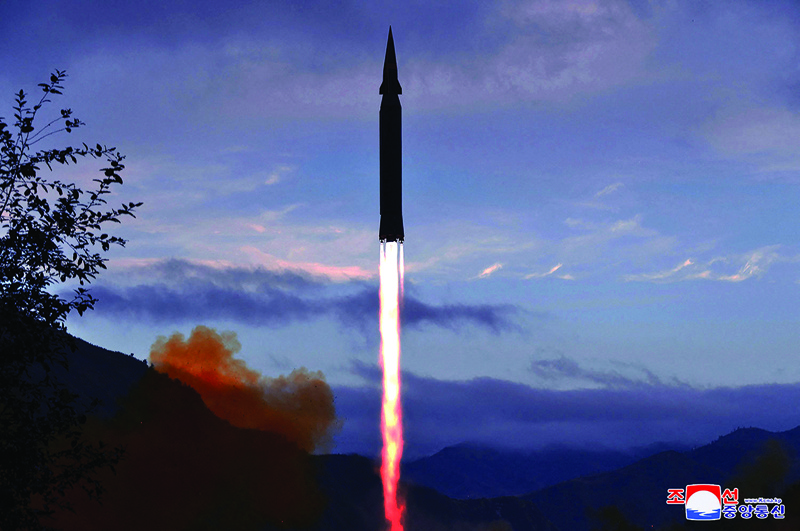 This picture released from North Korea's official Korean Central News Agency shows the Academy of Defense Science of the DPRK test-firing a hypersonic missile Hwasong-8 newly developed by it in Toyang-ri, Ryongrim County of Jagang Province, North Korea. - AFP
This picture released from North Korea's official Korean Central News Agency shows the Academy of Defense Science of the DPRK test-firing a hypersonic missile Hwasong-8 newly developed by it in Toyang-ri, Ryongrim County of Jagang Province, North Korea. - AFPSEOUL: In the latest provocation by "rocket man" Kim Jong Un, North Korea said it successfully tested a new hypersonic gliding missile, in its latest advance in weapons technology. Here we look back at the development of the regime's banned nuclear weapons and ballistic missile programs:
The beginnings, 1970s
North Korea starts working in the late 1970s on a version of the Soviet Scud-B missile with a range of around 300 kilometers, carrying out its first test in 1984. Between 1987 and 1992, it begins developing longer-range missiles, including the Taepodong-1 (2,500 km/1,500 miles) and Taepodong-2 (6,700 km/4,200 miles). The Taepodong-1 is test-fired over Japan in 1998 but the following year, Pyongyang declares a moratorium on such tests as ties with the United States improve.
First nuclear test in 2006
It ends the moratorium in 2005, blaming the Bush administration's "hostile" policy, and carries out its first nuclear test on October 9, 2006. In May 2009, there is a second underground nuclear test, several times more powerful than the first. Kim Jong Un succeeds his father Kim Jong Il - who dies in December 2011 - and oversees a third nuclear test in 2013.
2016, Japanese waters reached
There is a fourth underground nuclear test in January 2016, which Pyongyang claims is a hydrogen bomb. In March, Kim Jong Un claims the North has successfully miniaturized a thermonuclear warhead, and in April it test-fires a submarine-launched ballistic missile. On August 3, it fires, for the first time, a ballistic missile directly into Japanese-controlled waters. Later that month, it successfully test-fires another submarine-launched ballistic missile. There is a fifth nuclear test on September 9.
2017, Japan and Guam under threat
Between February and May, the North tests a series of ballistic missiles that fall into the Sea of Japan. Pyongyang claims these are exercises to hit US bases in Japan. A test on May 14 is of a "newly developed mid/long-range strategic ballistic rocket, Hwasong-12", Pyongyang says. It flies 700 kilometers before landing in the Sea of Japan.
Two months later, North Korea announces it successfully tested on July 4 - the US independence day - an ICBM capable of reaching Alaska, a gift for the "American bastards". There is a second successful ICBM test on July 28. Hours after US President Donald Trump threatens Pyongyang on August 8 with "fire and fury" over its missile program, the North says it is considering strikes near US strategic military installations in Guam.
Largest nuclear test yet
On September 3, 2017, North Korea conducts its sixth and largest nuclear test. Monitoring groups estimate a yield of 250 kilotons, which is 16 times the size of the 15-kiloton US bomb that destroyed Hiroshima in 1945. On September 15, less than a week after the UN adopts an eighth series of sanctions, North Korea fires an intermediate-range missile over Japan. On November 20, Washington declares North Korea a state sponsor of terrorism, a day before adding to pressure on the isolated state with fresh sanctions.
On November 29, North Korea launches a new Hwasong-15 ICBM, which it claims could deliver a "super-large heavy warhead" anywhere on the US mainland. Analysts agree the rocket is capable of reaching the US but voice scepticism that Pyongyang has mastered the advanced technology needed to allow the rocket to survive re-entry into the Earth's atmosphere. Weeks later on December 13, Kim vows to make North Korea the "world's strongest nuclear power".
2018, Olympic detente triggers thaw
In his New Year speech, Kim states the development of North Korea's nuclear force has been completed. Catalyzed by the Winter Olympics in the South, a rapid diplomatic thaw begins in February. On April 21, Pyongyang declares that nuclear blasts and ICBM launches will cease immediately and the atomic test site at Punggye-ri will be dismantled to "transparently guarantee" the end of testing. Kim adds that the possession of nuclear weapons was "the firm guarantee by which our descendants can enjoy the most dignified and happiest life in the world".
Fresh tensions
After the Hanoi summit in February 2019, negotiations between the US and North Korea are deadlocked. In mid-September 2021 North Korea test-fires a new "long-range cruise missile", according to state media and then launches two ballistic missiles into the sea, according to the South Korean army. On the 28, North Korea fires a presumed short-range missile into the sea, as Pyongyang's UN ambassador insists it had an undeniable right to test its weapons. Yesterday North Korea said it has successfully tested a new hypersonic gliding missile, identified as the Hwasong-8. - AFP










